
Pareiasaurs are an extinct clade of large, herbivorous parareptiles. Members of the group were armoured with osteoderms which covered large areas of the body. They first appeared in southern Pangea during the Middle Permian, before becoming globally distributed during the Late Permian. Pareiasaurs were the largest reptiles of the Permian, reaching sizes equivalent to those of contemporary therapsids. Pareiasaurs became extinct in the Permian–Triassic extinction event.

Temnospondyli or temnospondyls is a diverse ancient order of small to giant tetrapods—often considered primitive amphibians—that flourished worldwide during the Carboniferous, Permian and Triassic periods, with fossils being found on every continent. A few species continued into the Jurassic and Early Cretaceous periods, but all had gone extinct by the Late Cretaceous. During about 210 million years of evolutionary history, they adapted to a wide range of habitats, including freshwater, terrestrial, and even coastal marine environments. Their life history is well understood, with fossils known from the larval stage, metamorphosis and maturity. Most temnospondyls were semiaquatic, although some were almost fully terrestrial, returning to the water only to breed. These temnospondyls were some of the first vertebrates fully adapted to life on land. Although temnospondyls are amphibians, many had characteristics such as scales and armour-like bony plates that distinguish them from the modern soft-bodied lissamphibians.

Coelurosauravus is an extinct genus of gliding reptile, known from the Late Permian of Madagascar. Like other members of the family Weigeltisauridae, members of this genus possessed long, rod-like ossifications projecting outwards from the body. These bony rods were not extensions of the ribs but were instead a feature unique to weigeltisaurids. It is believed that during life, these structures formed folding wings used for gliding flight, similar to living gliding Draco lizards.
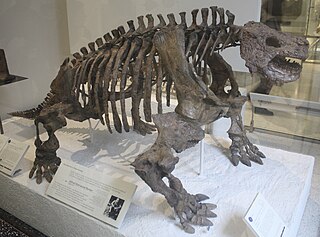
Scutosaurus is an extinct genus of pareiasaur parareptiles. Its genus name refers to large plates of armor scattered across its body. It was a large anapsid reptile that, unlike most reptiles, held its legs underneath its body to support its great weight. Fossils have been found in the Sokolki Assemblage Zone of the Malokinelskaya Formation in European Russia, close to the Ural Mountains, dating to the late Permian (Lopingian) between 264 and 252 million years ago.

Cochleosaurus (“spoon lizard”, from the Latin cochlear "spoon" and Greek sauros “lizard”_ were medium-sized edopoid temnospondyls that lived in Euramerica during the Muscovian period. Two species, C. bohemicus and C. florensis, have been identified from the fossil record.
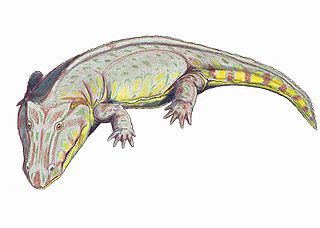
Edops is an extinct genus of temnospondyl amphibian from the Late Carboniferous - Early Permian periods. Unlike more advanced temnospondyls of the time, such as Eryops, Edops exhibited an archaic pattern of palatal bones, and still possessed various additional bones at the back of the skull. Edopoids also had particularly big premaxillae and proportionally small external nostrils. Within the clade, the most basal member seems to be Edops from the Early Permian Archer City Formation of the US, a broad-skulled animal with large palatal teeth.

Bolosaurus is an extinct genus of bolosaurid reptile from the Cisuralian epoch of North Asia and North America.

Capetus is an extinct genus of temnospondyl from the Upper Carboniferous of the Czech Republic. It reached a length of 150 cm.
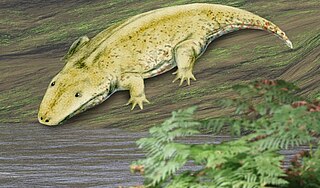
Saharastega is an extinct genus of basal temnospondyl which lived during the Late Permian period, around 251 to 260 million years ago. Remains of Saharastega, discovered by paleontologist Christian Sidor at the Moradi Formation in Niger, were described briefly in 2005 and more comprehensively in 2006. The description is based on a skull lacking the lower jaws.

Nigerpeton is an extinct genus of crocodile-like temnospondyls from the late Permian (Changhsingian) period. These temnospondyls lived in modern-day Niger, which was once part of central Pangaea, about 250 million years ago. Nigerpeton is a member of the Cochleosauridae family, a group of edopoid temnospondyl amphibians known from the late Carboniferous (Pennsylvanian) and early Permian (Cisuralian).

Aerosaurus is an extinct genus within Varanopidae, a family of non-mammalian synapsids. It lived between 252-299 million years ago during the Early Permian in North America. The name comes from Latin aes (aeris) “copper” and Greek sauros “lizard,” for El Cobre Canyon in northern New Mexico, where the type fossil was found and the site of former copper mines. Aerosaurus was a small to medium-bodied carnivorous synapsid characterized by its recurved teeth, triangular lateral temporal fenestra, and extended teeth row. Two species are recognized: A. greenleeorum (1937) and A. wellesi (1981).
Christian Alfred Sidor is an American vertebrate paleontologist. He is currently a Professor in the Department of Biology, University of Washington in Seattle, as well as Curator of Vertebrate Paleontology and Associate Director for Research and Collections at the Burke Museum of Natural History and Culture. His research focuses on Permian and Triassic tetrapod evolution, especially on therapsids.

Velosauria is a group of pareiasaur reptiles that existed in the late Permian period. They ranged in size from the 50-centimeter-long Pumiliopareia to the 3-meter-long Scutosaurus. Velosaurs were some of the largest reptiles of their time.

Adamanterpeton is a genus of Edopoid Temnospondyl within the family Cochleosauridae. The type species A. ohioensis was named in 1998 and is currently the only known species within this genus. Adamanterpeton is rare in the Linton vertebrate assemblage, with other amphibians like Sauropleura, Ophiderpeton, and Colosteus being more common. Unlike other Linton vertebrates, Adamanterpeton may have been adapted to a terrestrial lifestyle.

Edopoidea is a clade of primitive temnospondyl amphibians including the genus Edops and the family Cochleosauridae. Edopoids are known from the Late Carboniferous and Early Permian of North America and Europe, and the Late Permian of Africa. They are among the most basal temnospondyls, and possess a number of primitive features that were lost in later members of the group.

The Usili Formation is a Late Permian geologic formation in Tanzania. It preserves fossils of many terrestrial vertebrates from the Permian, including temnospondyls, pareiasaurs, therapsids and the archosauromorph Aenigmastropheus.
The Moradi Formation is a geological formation in Niger. It is of Late Permian age. It is informally divided into three subunits. The lower portion of the formation consists of red mudstone, with muddy calcareous sandstone and quartz-granlule conglomerate present as lenses. The middle portion consists of muddy siltstone in thick beds interbedded with red argillaceous sandstone. The lower two thirds of the upper portion of the formation consist of red siltstone intercalated with channel lag intraformational conglomerates, while the upper third consists of barchanoid shaped lenses of conglomeratic sandstone with ventifacts. These facies are indicatived of deposition under arid conditions, with less than 300 millimetres (12 in) of annual rainfall in the Central Pangean desert, with annual temperatures of 30 to 35 °C, but with ephemeral water presence including lakes.
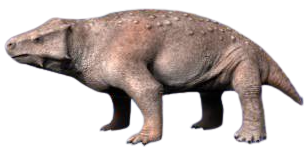
Parasaurus is a genus of pareiasaur known from fossils collected in the Kupferschiefer in Germany, dating to the Late Permian (Wuchiapingian). The type species, Parasaurus geinitzi, described by Hermann von Meyer in 1857, was the first pareiasaur ever described. The seven known specimens were redescribed in 2008.
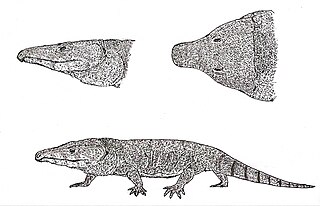
Moradisaurus is an extinct genus of large captorhinid reptile, with a single species Moradisaurus grandis, known from the late Permian (Lopingian) aged Moradi Formation of Niger. It is the largest captorhinid known, estimated to have reached a snout-vent length of over two metres. Similar to other members of Moradisaurinae, it possessed multiple tooth rows, which is associated with a high-fiber herbivorous diet.


















